
Chapter 9: Meiosis and the Genetic Basis of Sexual Reproduction
9.1 An Overview of Meiosis
Meiosis is a type of cell division that reduces the chromosome number from diploid (2 sets of chromosomes) to haploid (1 set of chromosomes).
Meiosis produces genetically different gametes, called sperm (males) and eggs (females).
The unique combination of chromosomes and genes in each offspring is due to random fertilization and the process of crossing over.
Crossing over is a process that occurs during meiosis, where homologous chromosomes exchange genetic material.
This process results in each gamete receiving a unique combination of chromosomes and genes from the parent cell.
The random fertilization of an egg by a sperm then further increases the genetic diversity of the offspring.
Homologous Chromosomes
Humans have 23 pairs of chromosomes, for a total of 46.
The first 22 pairs are called autosomes, and they are the same in both males and females.
The 23rd pair is the sex chromosomes, and they determine gender.
Females have two X chromosomes, and males have one X and one Y chromosome.
Homologous chromosomes are the members of a chromosome pair.
They have the same size, shape, and location of the centromere.
They contain the same types of genes arranged in the same order.
Alleles are alternate versions of a gene for a particular trait.
The location of the alleles of a gene on homologous chromosomes is the same, but the information within the alleles may be slightly different.
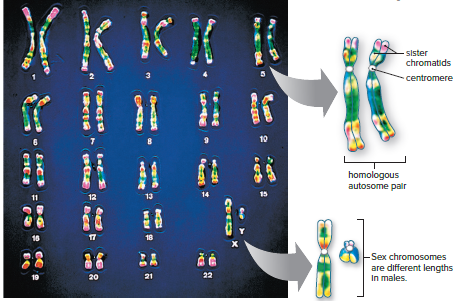
The Human Life Cycle
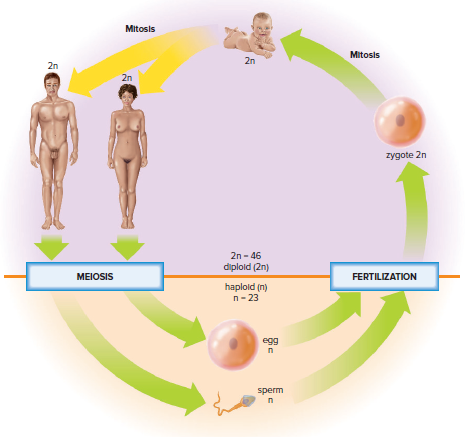
Mitosis: A type of cell division that results in two identical daughter cells.
Occurs in somatic cells (body cells)
Maintains the diploid number of chromosomes (46 in humans)
Meiosis: A type of cell division that results in four haploid daughter cells.
Occurs in gametes (sex cells)
Reduces the chromosome number from diploid to haploid (23 in humans)
Fertilization: The fusion of a sperm and an egg to form a zygote.
Results in the restoration of the diploid number of chromosomes (46 in humans)
Meiosis is important because it ensures that the number of chromosomes is maintained from one generation to the next.
Overview of Meiosis
Meiosis is a two-step process that results in four daughter cells with half the number of chromosomes as the parent cell.
During the first step of meiosis (meiosis I), homologous chromosomes (chromosomes that are similar in structure and function) pair up and exchange genetic material. This process, called crossing over, increases genetic diversity in the daughter cells.
After crossing over, the homologous chromosomes separate and are randomly distributed to the daughter cells. This means that each daughter cell receives a unique combination of chromosomes.
The second step of meiosis (meiosis II) is similar to mitosis, except that the chromosomes do not replicate. This results in four daughter cells with a haploid number of chromosomes (half the number of chromosomes as the parent cell).
The daughter cells produced by meiosis are gametes, which are reproductive cells that can fuse to form a new organism.
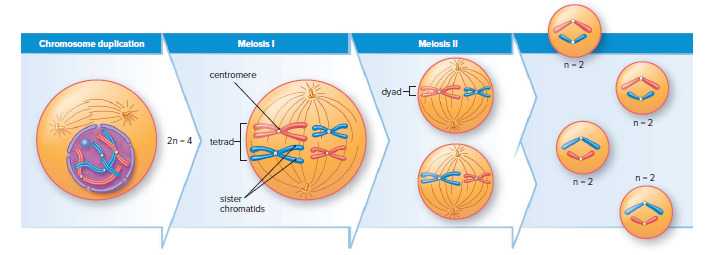
Crossing Over
Meiosis shuffles genetic information by exchanging genetic material between homologous chromosomes.
Crossing-over occurs when the non-sister chromatids of a tetrad exchange genetic material.
Crossing over increases the diversity of the gametes and, therefore, of the offspring.
At fertilization, new combinations of chromosomes can occur, resulting in a zygote with a vast number of possible chromosomal combinations.
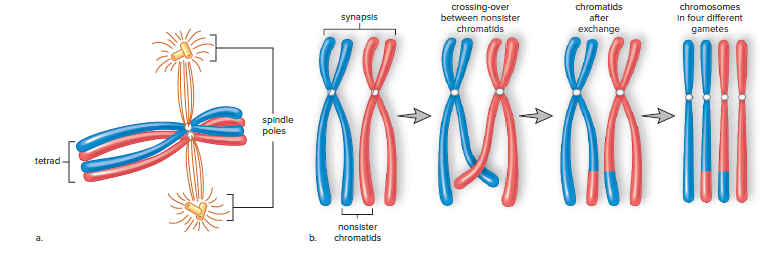
The Importance of Meiosis
It helps keep the chromosome number constant. Meiosis produces haploid daughter cells that become the gametes. When a haploid sperm fertilizes a haploid egg, the new individual has the diploid number of chromosomes.
It introduces genetic variations. Meiosis introduces genetic variations because of two processes:
Crossing-over can result in different types of alleles on the sister chromatids of a homologue.
Every possible combination of chromosomes can occur in the daughter cells.

9.2 The Phases of Meiosis
Prophase: The chromosomes condense, and the nuclear envelope breaks down.
Metaphase: The chromosomes line up along the metaphase plate.
Anaphase: The centromeres of the chromosomes split, and the sister chromatids are pulled apart to opposite poles of the cell.
Telophase: The chromosomes uncoil, and the nuclear envelope reforms.
Meiosis I and meiosis II differ from mitosis in that the way chromosomes align during metaphase.
The First Division--Meiosis I
Meiosis produces gametes with reduced chromosome numbers and genetic diversity.
Prophase I: nuclear envelope fragments, the nucleolus disappears, spindle appears, chromosomes condense, homologs undergo synapsis to produce tetrads, and crossing-over occurs between non-sister chromatids.
Metaphase I: tetrads attach to the spindle and align at the spindle equator; each homolog faces the opposite spindle pole, and all possible combinations of chromosomes occur in gametes.
Anaphase I: homologous chromosomes separate.
Telophase and cytokinesis: daughter nuclei are haploid, each containing one chromosome from each homologous pair; chromosomes are dyads with two sister chromatids.
No DNA replication occurs between meiosis I and II, called interkinesis.
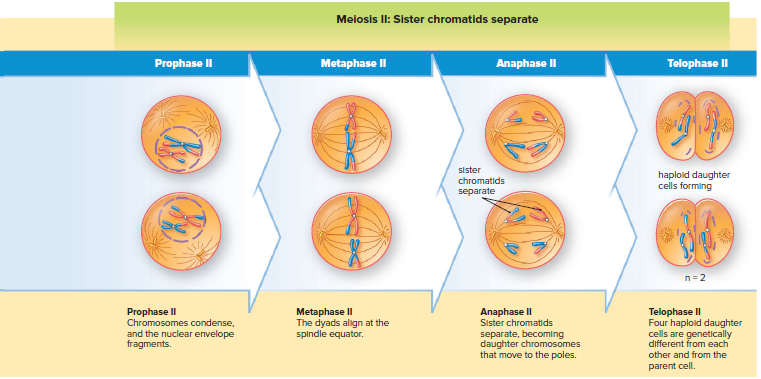
The Second Division--Meiosis II
Meiosis II is the second and final stage of meiosis.
It is similar to mitosis, but the cells are haploid.
The following events occur during meiosis II:
Prophase II:
The nuclear envelope breaks down.
The nucleolus disappears.
The chromosomes condense.
The spindle fibers form.
Metaphase II:
The chromosomes line up at the metaphase plate.
The sister chromatids are attached to the spindle fibers.
Anaphase II:
The sister chromatids separate.
The chromosomes move to opposite poles of the cell.
Telophase II:
The nuclear envelopes reform.
The chromosomes decondense.
Cytokinesis occurs, dividing the cell into two haploid cells.
The gametes produced by meiosis are genetically different from each other because of crossing-over and independent assortment.
Crossing-over is a process that occurs during prophase I of meiosis, in which homologous chromosomes exchange genetic material.
Independent assortment is a process that occurs during metaphase I of meiosis, in which the homologous chromosomes randomly align at the metaphase plate.
As a result of crossing-over and independent assortment, the gametes produced by meiosis have a unique combination of genes.
9.3 Meiosis Compared with Mitosis
The number of nuclear divisions: Meiosis requires two consecutive nuclear divisions, while mitosis requires only one nuclear division.
The number of daughter cells: Meiosis produces four daughter cells, while mitosis produces two daughter cells.
Chromosome number: The four daughter cells produced by meiosis are haploid, meaning they have half the number of chromosomes as the parent cell. The daughter cells produced by mitosis have the same number of chromosomes as the parent cell.
Genetic diversity: The daughter cells produced by meiosis are genetically different from each other and from the parent cell. The daughter cells produced by mitosis are genetically identical to each other and to the parent cell.
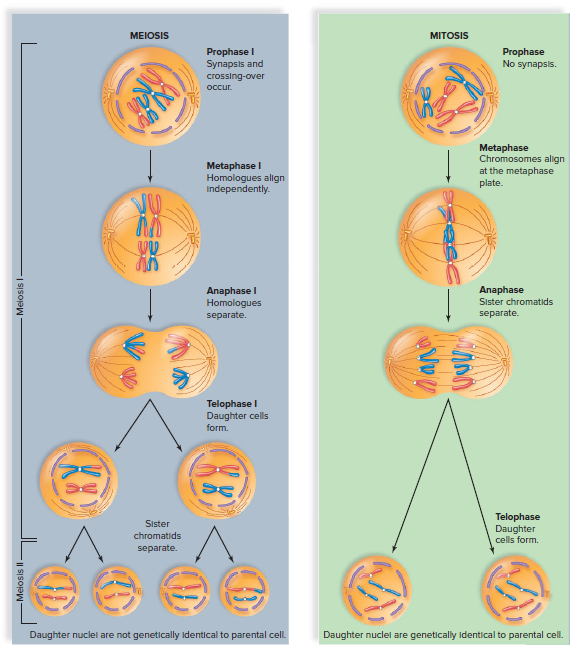
Meiosis I Compared with Mitosis
Synapsis: During prophase I of meiosis, homologous chromosomes pair up and form tetrads. This does not happen during mitosis.
Crossing over: During synapsis, homologous chromosomes can exchange genetic material. This does not happen during mitosis.
Chromosome alignment: During metaphase I of meiosis, tetrads align at the spindle equator. During metaphase of mitosis, dyads align separately at the spindle equator.
Chromosome separation: During anaphase I of meiosis, homologous chromosomes of each tetrad separate. During anaphase of mitosis, sister chromatids separate.
Meiosis II Compared with Mitosis
The events of meiosis II are like those of mitosis, except that in meiosis II the cells have the haploid number of chromosomes.
Mitosis and Meiosis Occur at Different Times
Meiosis
Occurs only at certain times in the life cycle of sexually reproducing organisms.
Only occurs in specialized tissues, such as the testes and ovaries.
In humans, meiosis occurs only in the testes and ovaries, where it is involved in the production of gametes (sex cells).
Functions of meiosis:
Provide gamete variation
Keep the chromosome number constant generation after generation
Fertilization:
Full chromosome number is restored
Gametes fuse, introducing great genetic diversity into the offspring
Mitosis
Much more common than meiosis.
Occurs in all tissues during embryonic development and during growth and repair.
The function of mitosis:
Keep the chromosome number constant in all the cells of the body.
Every cell has the same genetic material.
Allows organisms, such as humans, to produce both the cells needed for the body to function and the cells used for reproduction.
9.4 Changes in Chromosomes Number
Nondisjunction is a chromosomal abnormality that occurs during meiosis, the process by which gametes (sex cells) are produced.
During nondisjunction, homologous chromosomes or sister chromatids fail to separate properly, resulting in daughter cells with an abnormal number of chromosomes.
If nondisjunction occurs during meiosis I, the daughter cells will have one more or one less chromosome than normal.
If nondisjunction occurs during meiosis II, the daughter cells will have one more or one less chromosome pair than normal.
Trisomy is a condition in which a person has an extra copy of a chromosome.
Monosomy is a condition in which a person is missing a copy of a chromosome.
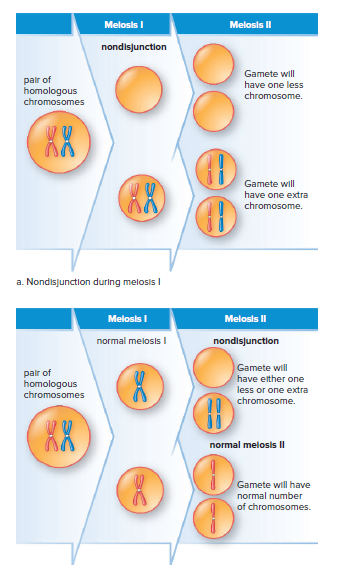
Down Syndrome
Down syndrome is a genetic disorder caused by an extra copy of chromosome 21.
People with Down syndrome have a wide range of physical and intellectual abilities.
Some common physical characteristics of Down syndrome include: short stature, upward-slanting eyes, small ears, a flat face, and a single crease across the palm of the hand.
Some common intellectual disabilities associated with Down syndrome include mild to moderate cognitive impairment, delayed language development, and difficulty with fine motor skills.
The risk of having a child with Down syndrome increases with the mother's age.
The frequency of Down syndrome is 1 in 800 births for mothers under 40 years of age and 1 in 80 for mothers over 40.
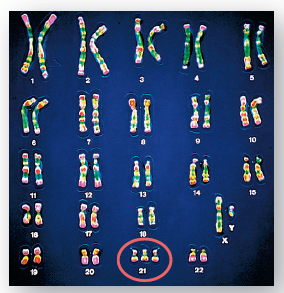
Abnormal Sex Chromosome Number
Nondisjunction during oogenesis or spermatogenesis can result in gametes with an abnormal number of X or Y chromosomes.
Additional or missing X or Y chromosomes cause certain syndromes, just like an extra copy of chromosome 21 causes Down syndrome.
Newborns with abnormal sex chromosome numbers are more likely to survive than those with abnormal autosome numbers.
Females and males normally have only one functioning X chromosome, and the other X chromosome is inactivated by a process called X-inactivation, producing an inactive chromosome called a Barr body.
X inactivation is a form of epigenetic inheritance.
The presence of a Y chromosome, not the number of X chromosomes, almost always determines maleness in humans.
The SRY gene located on the short arm of the Y chromosome produces a hormone called the testis-determining factor, which plays a critical role in the development of male genitals.
Individuals lacking a functional SRY on their Y chromosome have Swyer syndrome and are also known as “XY females.”
A person with Turner syndrome (45, XO) is a female with underdeveloped ovaries, uterine tubes, and uterus. They do not undergo puberty or menstruate, and their breasts do not develop.
A person with Klinefelter syndrome (47, XXY) is a male with underdeveloped testes and prostate gland. They may have some breast development and are usually slow to learn but are not mentally handicapped unless they inherit more than two X chromosomes.
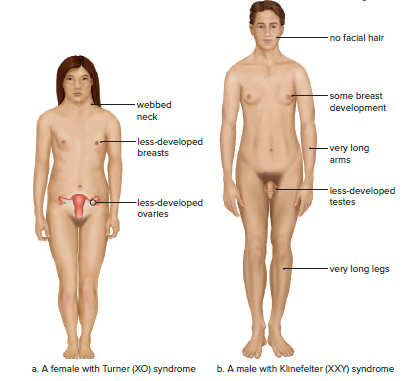
Chapter 9: Meiosis and the Genetic Basis of Sexual Reproduction
9.1 An Overview of Meiosis
Meiosis is a type of cell division that reduces the chromosome number from diploid (2 sets of chromosomes) to haploid (1 set of chromosomes).
Meiosis produces genetically different gametes, called sperm (males) and eggs (females).
The unique combination of chromosomes and genes in each offspring is due to random fertilization and the process of crossing over.
Crossing over is a process that occurs during meiosis, where homologous chromosomes exchange genetic material.
This process results in each gamete receiving a unique combination of chromosomes and genes from the parent cell.
The random fertilization of an egg by a sperm then further increases the genetic diversity of the offspring.
Homologous Chromosomes
Humans have 23 pairs of chromosomes, for a total of 46.
The first 22 pairs are called autosomes, and they are the same in both males and females.
The 23rd pair is the sex chromosomes, and they determine gender.
Females have two X chromosomes, and males have one X and one Y chromosome.
Homologous chromosomes are the members of a chromosome pair.
They have the same size, shape, and location of the centromere.
They contain the same types of genes arranged in the same order.
Alleles are alternate versions of a gene for a particular trait.
The location of the alleles of a gene on homologous chromosomes is the same, but the information within the alleles may be slightly different.

The Human Life Cycle

Mitosis: A type of cell division that results in two identical daughter cells.
Occurs in somatic cells (body cells)
Maintains the diploid number of chromosomes (46 in humans)
Meiosis: A type of cell division that results in four haploid daughter cells.
Occurs in gametes (sex cells)
Reduces the chromosome number from diploid to haploid (23 in humans)
Fertilization: The fusion of a sperm and an egg to form a zygote.
Results in the restoration of the diploid number of chromosomes (46 in humans)
Meiosis is important because it ensures that the number of chromosomes is maintained from one generation to the next.
Overview of Meiosis
Meiosis is a two-step process that results in four daughter cells with half the number of chromosomes as the parent cell.
During the first step of meiosis (meiosis I), homologous chromosomes (chromosomes that are similar in structure and function) pair up and exchange genetic material. This process, called crossing over, increases genetic diversity in the daughter cells.
After crossing over, the homologous chromosomes separate and are randomly distributed to the daughter cells. This means that each daughter cell receives a unique combination of chromosomes.
The second step of meiosis (meiosis II) is similar to mitosis, except that the chromosomes do not replicate. This results in four daughter cells with a haploid number of chromosomes (half the number of chromosomes as the parent cell).
The daughter cells produced by meiosis are gametes, which are reproductive cells that can fuse to form a new organism.

Crossing Over
Meiosis shuffles genetic information by exchanging genetic material between homologous chromosomes.
Crossing-over occurs when the non-sister chromatids of a tetrad exchange genetic material.
Crossing over increases the diversity of the gametes and, therefore, of the offspring.
At fertilization, new combinations of chromosomes can occur, resulting in a zygote with a vast number of possible chromosomal combinations.

The Importance of Meiosis
It helps keep the chromosome number constant. Meiosis produces haploid daughter cells that become the gametes. When a haploid sperm fertilizes a haploid egg, the new individual has the diploid number of chromosomes.
It introduces genetic variations. Meiosis introduces genetic variations because of two processes:
Crossing-over can result in different types of alleles on the sister chromatids of a homologue.
Every possible combination of chromosomes can occur in the daughter cells.

9.2 The Phases of Meiosis
Prophase: The chromosomes condense, and the nuclear envelope breaks down.
Metaphase: The chromosomes line up along the metaphase plate.
Anaphase: The centromeres of the chromosomes split, and the sister chromatids are pulled apart to opposite poles of the cell.
Telophase: The chromosomes uncoil, and the nuclear envelope reforms.
Meiosis I and meiosis II differ from mitosis in that the way chromosomes align during metaphase.
The First Division--Meiosis I
Meiosis produces gametes with reduced chromosome numbers and genetic diversity.
Prophase I: nuclear envelope fragments, the nucleolus disappears, spindle appears, chromosomes condense, homologs undergo synapsis to produce tetrads, and crossing-over occurs between non-sister chromatids.
Metaphase I: tetrads attach to the spindle and align at the spindle equator; each homolog faces the opposite spindle pole, and all possible combinations of chromosomes occur in gametes.
Anaphase I: homologous chromosomes separate.
Telophase and cytokinesis: daughter nuclei are haploid, each containing one chromosome from each homologous pair; chromosomes are dyads with two sister chromatids.
No DNA replication occurs between meiosis I and II, called interkinesis.

The Second Division--Meiosis II
Meiosis II is the second and final stage of meiosis.
It is similar to mitosis, but the cells are haploid.
The following events occur during meiosis II:
Prophase II:
The nuclear envelope breaks down.
The nucleolus disappears.
The chromosomes condense.
The spindle fibers form.
Metaphase II:
The chromosomes line up at the metaphase plate.
The sister chromatids are attached to the spindle fibers.
Anaphase II:
The sister chromatids separate.
The chromosomes move to opposite poles of the cell.
Telophase II:
The nuclear envelopes reform.
The chromosomes decondense.
Cytokinesis occurs, dividing the cell into two haploid cells.
The gametes produced by meiosis are genetically different from each other because of crossing-over and independent assortment.
Crossing-over is a process that occurs during prophase I of meiosis, in which homologous chromosomes exchange genetic material.
Independent assortment is a process that occurs during metaphase I of meiosis, in which the homologous chromosomes randomly align at the metaphase plate.
As a result of crossing-over and independent assortment, the gametes produced by meiosis have a unique combination of genes.
9.3 Meiosis Compared with Mitosis
The number of nuclear divisions: Meiosis requires two consecutive nuclear divisions, while mitosis requires only one nuclear division.
The number of daughter cells: Meiosis produces four daughter cells, while mitosis produces two daughter cells.
Chromosome number: The four daughter cells produced by meiosis are haploid, meaning they have half the number of chromosomes as the parent cell. The daughter cells produced by mitosis have the same number of chromosomes as the parent cell.
Genetic diversity: The daughter cells produced by meiosis are genetically different from each other and from the parent cell. The daughter cells produced by mitosis are genetically identical to each other and to the parent cell.

Meiosis I Compared with Mitosis
Synapsis: During prophase I of meiosis, homologous chromosomes pair up and form tetrads. This does not happen during mitosis.
Crossing over: During synapsis, homologous chromosomes can exchange genetic material. This does not happen during mitosis.
Chromosome alignment: During metaphase I of meiosis, tetrads align at the spindle equator. During metaphase of mitosis, dyads align separately at the spindle equator.
Chromosome separation: During anaphase I of meiosis, homologous chromosomes of each tetrad separate. During anaphase of mitosis, sister chromatids separate.
Meiosis II Compared with Mitosis
The events of meiosis II are like those of mitosis, except that in meiosis II the cells have the haploid number of chromosomes.
Mitosis and Meiosis Occur at Different Times
Meiosis
Occurs only at certain times in the life cycle of sexually reproducing organisms.
Only occurs in specialized tissues, such as the testes and ovaries.
In humans, meiosis occurs only in the testes and ovaries, where it is involved in the production of gametes (sex cells).
Functions of meiosis:
Provide gamete variation
Keep the chromosome number constant generation after generation
Fertilization:
Full chromosome number is restored
Gametes fuse, introducing great genetic diversity into the offspring
Mitosis
Much more common than meiosis.
Occurs in all tissues during embryonic development and during growth and repair.
The function of mitosis:
Keep the chromosome number constant in all the cells of the body.
Every cell has the same genetic material.
Allows organisms, such as humans, to produce both the cells needed for the body to function and the cells used for reproduction.
9.4 Changes in Chromosomes Number
Nondisjunction is a chromosomal abnormality that occurs during meiosis, the process by which gametes (sex cells) are produced.
During nondisjunction, homologous chromosomes or sister chromatids fail to separate properly, resulting in daughter cells with an abnormal number of chromosomes.
If nondisjunction occurs during meiosis I, the daughter cells will have one more or one less chromosome than normal.
If nondisjunction occurs during meiosis II, the daughter cells will have one more or one less chromosome pair than normal.
Trisomy is a condition in which a person has an extra copy of a chromosome.
Monosomy is a condition in which a person is missing a copy of a chromosome.

Down Syndrome
Down syndrome is a genetic disorder caused by an extra copy of chromosome 21.
People with Down syndrome have a wide range of physical and intellectual abilities.
Some common physical characteristics of Down syndrome include: short stature, upward-slanting eyes, small ears, a flat face, and a single crease across the palm of the hand.
Some common intellectual disabilities associated with Down syndrome include mild to moderate cognitive impairment, delayed language development, and difficulty with fine motor skills.
The risk of having a child with Down syndrome increases with the mother's age.
The frequency of Down syndrome is 1 in 800 births for mothers under 40 years of age and 1 in 80 for mothers over 40.

Abnormal Sex Chromosome Number
Nondisjunction during oogenesis or spermatogenesis can result in gametes with an abnormal number of X or Y chromosomes.
Additional or missing X or Y chromosomes cause certain syndromes, just like an extra copy of chromosome 21 causes Down syndrome.
Newborns with abnormal sex chromosome numbers are more likely to survive than those with abnormal autosome numbers.
Females and males normally have only one functioning X chromosome, and the other X chromosome is inactivated by a process called X-inactivation, producing an inactive chromosome called a Barr body.
X inactivation is a form of epigenetic inheritance.
The presence of a Y chromosome, not the number of X chromosomes, almost always determines maleness in humans.
The SRY gene located on the short arm of the Y chromosome produces a hormone called the testis-determining factor, which plays a critical role in the development of male genitals.
Individuals lacking a functional SRY on their Y chromosome have Swyer syndrome and are also known as “XY females.”
A person with Turner syndrome (45, XO) is a female with underdeveloped ovaries, uterine tubes, and uterus. They do not undergo puberty or menstruate, and their breasts do not develop.
A person with Klinefelter syndrome (47, XXY) is a male with underdeveloped testes and prostate gland. They may have some breast development and are usually slow to learn but are not mentally handicapped unless they inherit more than two X chromosomes.

 Knowt
Knowt
